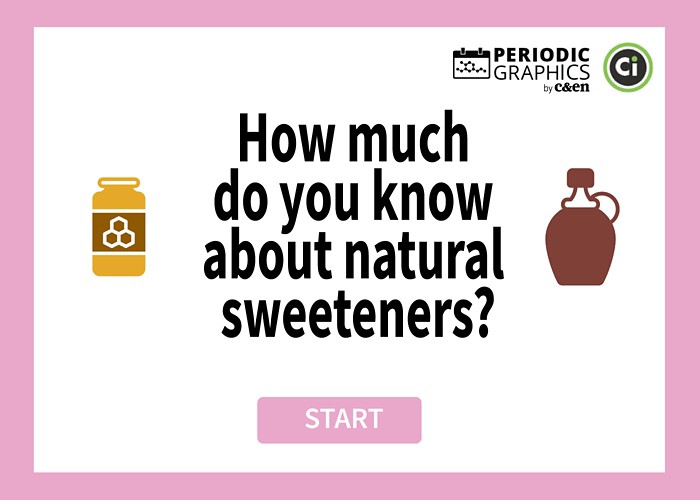Advertisement
Grab your lab coat. Let's get started
Welcome!
Welcome!
Create an account below to get 6 C&EN articles per month, receive newsletters and more - all free.
It seems this is your first time logging in online. Please enter the following information to continue.
As an ACS member you automatically get access to this site. All we need is few more details to create your reading experience.
Not you? Sign in with a different account.
Not you? Sign in with a different account.
ERROR 1
ERROR 1
ERROR 2
ERROR 2
ERROR 2
ERROR 2
ERROR 2
Password and Confirm password must match.
If you have an ACS member number, please enter it here so we can link this account to your membership. (optional)
ERROR 2
ACS values your privacy. By submitting your information, you are gaining access to C&EN and subscribing to our weekly newsletter. We use the information you provide to make your reading experience better, and we will never sell your data to third party members.
Food Ingredients
Editorial: Fewer risky food colors, please
by C&EN editorial staff
August 23, 2024
| A version of this story appeared in
Volume 102, Issue 26

In 2021, when regulators warned a bakery in Leeds, England, to stop using illegal sprinkles, the owner thought it was a joke. But indeed, the brightly colored sprinkles used to decorate the bakery’s best-selling raspberry glazed doughnut cookies contained erythrosin, also known as red no. 3 dye. The dye is banned in food in the UK and the European Union, except in cocktail cherries. The bakery reluctantly stopped using the forbidden sprinkles but complained that the ones sold in the UK are too dull.
The bakery had purchased the sprinkles from a wholesaler that imported them from the US. Red no. 3 dye is allowed in food sold in the US, but it won’t be permitted for long in California, which banned the dye in food last year, effective January 1, 2027. Several other states are also considering banning the dye.
The US Food and Drug Administration has been dragging its feet for years to address the health risks of red no. 3 dye in food. The agency banned its use in cosmetics in 1990 when studies showed that the color additive causes cancer in laboratory animals. But the FDA still allows red no. 3 dye in food.
Consumer advocacy groups petitioned the agency in 2022 to ban red no. 3 dye in food, citing newer studies that reinforce the FDA’s 1990 conclusion. The FDA expects to make a decision on the petition later this year.
It makes no sense from a public health perspective for the FDA to allow red no. 3 dye in food but not in cosmetics.
So why the inconsistency? The agency allows the dye in food because manufacturers have been pushing for decades to keep bright colors in food.
Titanium dioxide, which makes colors especially bright, was on the chopping block in California in the initial legislation that banned red no. 3 dye. But lawmakers stripped titanium dioxide from the final bill because of pressure from the National Confectioners Association.
Titanium dioxide was also initially on the list of synthetic food dyes targeted by the California School Food Safety Act currently before the state’s legislators. That bill would prohibit California public schools from serving food with any of six dyes linked to behavioral and developmental issues in children. But again, titanium dioxide did not make the list. California lawmakers are expected to vote on the bill by the end of August.
Natural pigments are available as alternatives, but they tend to be less stable and more expensive than synthetic colors. Natural colors are also typically not as bright as synthetic colors. And the brighter colors are known to attract consumers, particularly kids.
General Mills learned the hard way about consumer preferences when it replaced neon-bright synthetic dyes in Trix cereal with natural dyes in 2016. After numerous consumer complaints, the company brought back a version of the cereal with the original dyes. Now the company offers both versions.
Consumers should have a choice in whether they eat food with synthetic colors made from petroleum-based raw materials or natural colors derived from plants, minerals, and in the case of cochineal extract, insects. But regardless of the source, regulators should ensure that color additives don’t increase the risk of cancer or hyperactivity in kids.
When national agencies like the FDA don’t act to protect public health, state or regional regulators, like the EU, step in. These differences in regulation from one country to another or from one US state to another cause confusion and headaches for food manufacturers and small business owners. But they could cause much worse for parents and their children.
This editorial is the result of collective deliberation in C&EN. For this week’s editorial, the lead contributor is Britt Erickson.
Views expressed on this page are not necessarily those of ACS..





Join the conversation
Contact the reporter
Submit a Letter to the Editor for publication
Engage with us on Twitter